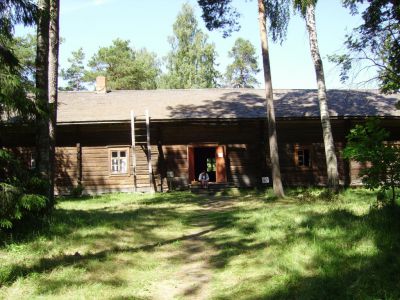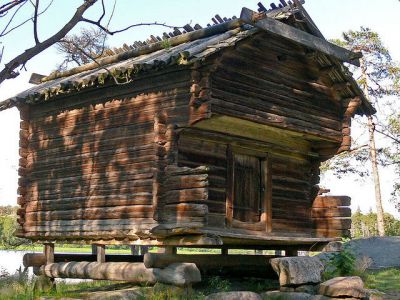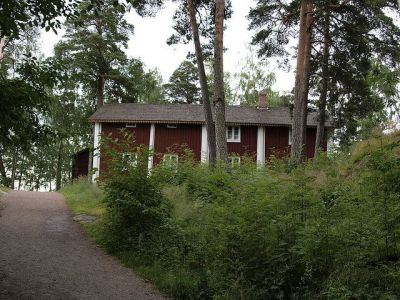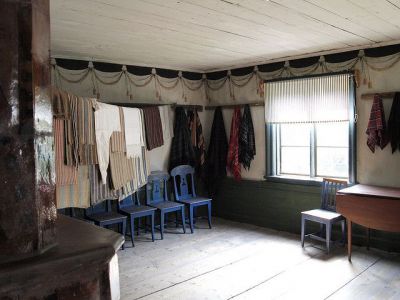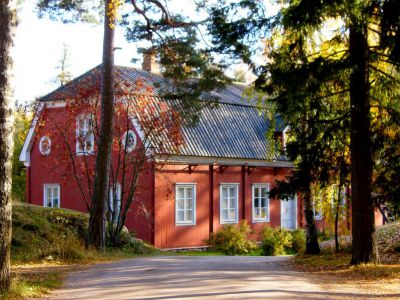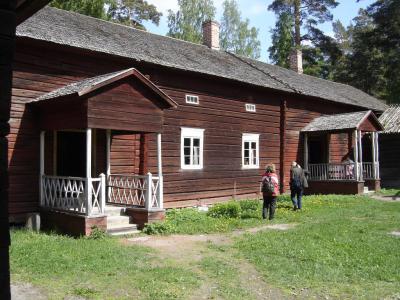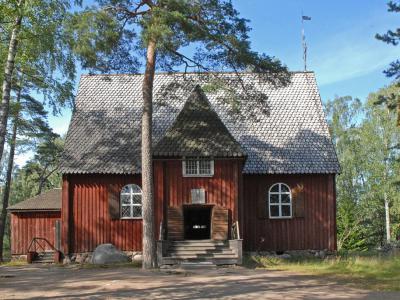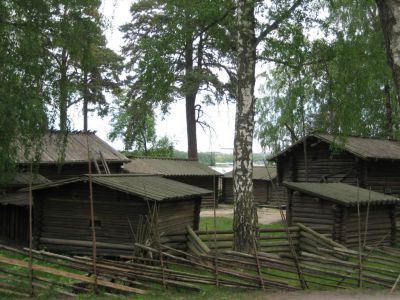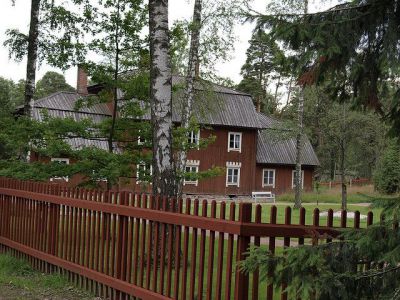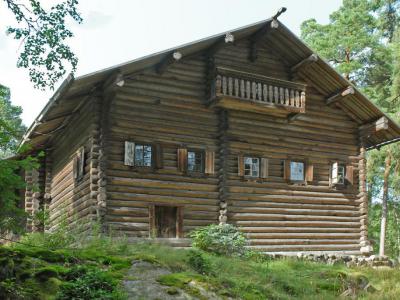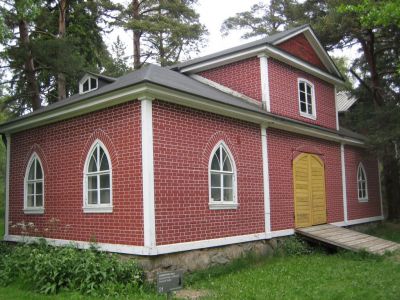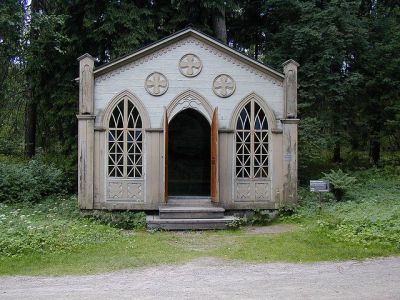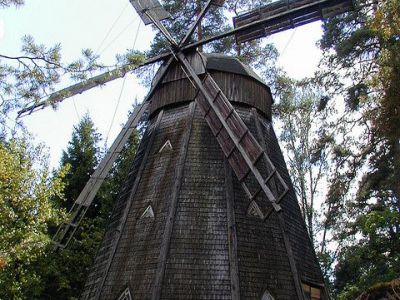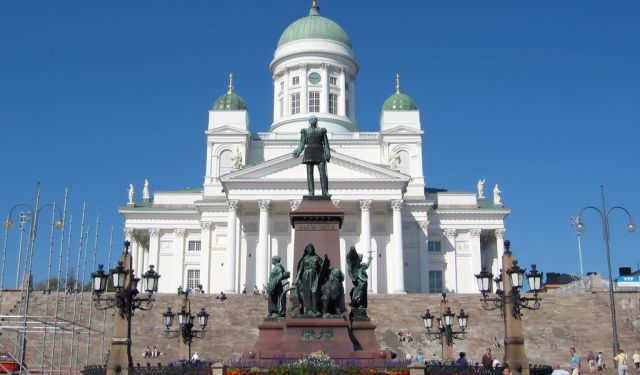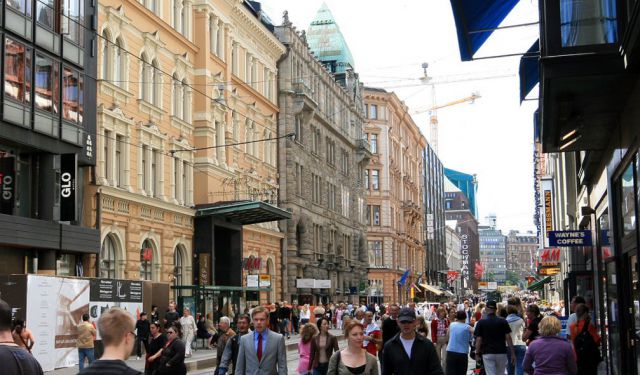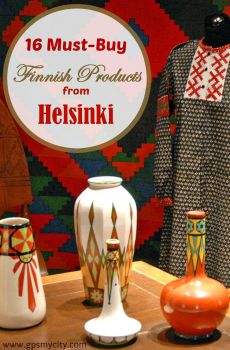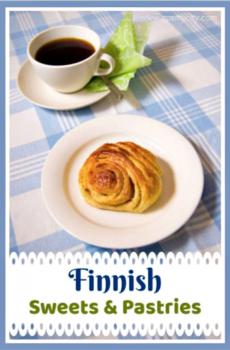Seurasaari Island Walking Tour (Self Guided), Helsinki
Seurasaari Island in Helsinki is best known as the home to the popular open-air museum. This venue offers a glimpse into the life of Finland's countryside in various epochs, showcasing old, mainly wooden houses, some of which – once lived in by famous people in Finnish history – were transplanted to the island and thus became part of the museum.
Among the notable attractions here are the Halla House, a traditional Finnish farmhouse, and the Granary from Paltamo, both highlighting the importance of agriculture in Finland.
Kurssi House, Ivars House, and Iisalmi Parsonage provide insights into the various aspects of rural life for different strata of society in the country. In the same vein, Antti Farmstead and Niemelä Tenant Farm depict the traditional way of living and farming in the countryside.
Karuna Church, on the other hand, is a beautiful wooden church with a unique charm that stands as a testament to Finland's religious past.
Kahiluoto Manor is a grand estate that offers a glimpse into the lives of the Finnish nobility, while Pertinotsa House provides insight into 19th-century North Russian-type of dwelling. The Yusupoff Stable, once the property of a Russian princess, is a fascinating structure that connects Seurasaari to Russian history.
Florin Summer House is a delightful spot for visitors to relax and enjoy the scenic beauty of Seurasaari. Additionally, the Windmill from Oripaa adds to the island's rustic charm and showcases traditional Finnish craftsmanship.
Seurasaari Island is also rich in wildlife. Every summer, locals, as well as tourists, come here to enjoy its peaceful outdoor atmosphere. So, why not plan a visit to Seurasaari now and immerse yourself in the fascinating history and culture of Finland? It's a place where you can learn, relax, and connect with the past, all while surrounded by the natural beauty of this island gem.
Among the notable attractions here are the Halla House, a traditional Finnish farmhouse, and the Granary from Paltamo, both highlighting the importance of agriculture in Finland.
Kurssi House, Ivars House, and Iisalmi Parsonage provide insights into the various aspects of rural life for different strata of society in the country. In the same vein, Antti Farmstead and Niemelä Tenant Farm depict the traditional way of living and farming in the countryside.
Karuna Church, on the other hand, is a beautiful wooden church with a unique charm that stands as a testament to Finland's religious past.
Kahiluoto Manor is a grand estate that offers a glimpse into the lives of the Finnish nobility, while Pertinotsa House provides insight into 19th-century North Russian-type of dwelling. The Yusupoff Stable, once the property of a Russian princess, is a fascinating structure that connects Seurasaari to Russian history.
Florin Summer House is a delightful spot for visitors to relax and enjoy the scenic beauty of Seurasaari. Additionally, the Windmill from Oripaa adds to the island's rustic charm and showcases traditional Finnish craftsmanship.
Seurasaari Island is also rich in wildlife. Every summer, locals, as well as tourists, come here to enjoy its peaceful outdoor atmosphere. So, why not plan a visit to Seurasaari now and immerse yourself in the fascinating history and culture of Finland? It's a place where you can learn, relax, and connect with the past, all while surrounded by the natural beauty of this island gem.
How it works: Download the app "GPSmyCity: Walks in 1K+ Cities" from Apple App Store or Google Play Store to your mobile phone or tablet. The app turns your mobile device into a personal tour guide and its built-in GPS navigation functions guide you from one tour stop to next. The app works offline, so no data plan is needed when traveling abroad.
Seurasaari Island Walking Tour Map
Guide Name: Seurasaari Island Walking Tour
Guide Location: Finland » Helsinki (See other walking tours in Helsinki)
Guide Type: Self-guided Walking Tour (Sightseeing)
# of Attractions: 13
Tour Duration: 2 Hour(s)
Travel Distance: 1.6 Km or 1 Miles
Author: DanaOffice
Sight(s) Featured in This Guide:
Guide Location: Finland » Helsinki (See other walking tours in Helsinki)
Guide Type: Self-guided Walking Tour (Sightseeing)
# of Attractions: 13
Tour Duration: 2 Hour(s)
Travel Distance: 1.6 Km or 1 Miles
Author: DanaOffice
Sight(s) Featured in This Guide:
- Halla House
- Granary from Paltamo
- Kurssi House
- Ivars House
- Iisalmi Parsonage
- Antti Farmstead
- Karuna Church
- Niemelä Tenant Farm
- Kahiluoto Manor
- Pertinotsa House
- The Yusupoff Stable
- Florin Summer House
- Windmill from Oripää
1) Halla House
An absolutely beautiful addition to the Seurasaari Island Open Air Museum in 1965 was the Halla house. It was moved to this famous institution from Hyrynsalmi, Finland, where it stood by itself on Hallavaara. It is representative of the Kainuu region of the country.
J.A. Heikkinen owned the farm. He is rather famous in the country because he was a Member of Parliament for a while. During his time in office, he helped to improve the situation for people who were farmers, and helped to get many people interested in agriculture. The homestead was also a stopover for the Jaeger family of Finland.
This place was occupied until the year 1958. During that whole time, the main room of the house was kept simple and functional. It was a farm, so the place saw chores and crafts, barreling and even slaughtering of animals. The room was also used by many people as a stopover place at night. It is said that the doors of the Halla house were never locked to anyone.
J.A. Heikkinen owned the farm. He is rather famous in the country because he was a Member of Parliament for a while. During his time in office, he helped to improve the situation for people who were farmers, and helped to get many people interested in agriculture. The homestead was also a stopover for the Jaeger family of Finland.
This place was occupied until the year 1958. During that whole time, the main room of the house was kept simple and functional. It was a farm, so the place saw chores and crafts, barreling and even slaughtering of animals. The room was also used by many people as a stopover place at night. It is said that the doors of the Halla house were never locked to anyone.
2) Granary from Paltamo
The Granary from Paltamo showcased in Seurasaaren Park in Helsinki, provides an intriguing peek into the nation's architectural and farming traditions. Established in 1909 by Professor Axel Olai Heikel, the Seurasaari Open Air Museum aims to conserve and present Finland's architectural heritage. Among the 87 structures brought from different Finnish regions to Seurasaari, the 17th-century grain barn from Melalahti village in Paltamo catches attention as one of the oldest and most captivating exhibits.
This granary, originally from the Junttila farm, was built in 1698, as indicated proudly by an inscription on its door. It served its purpose until 1723, storing grain while using clever methods to protect its contents. Reflecting the Northern Ostrobothnia style influenced by Russian architecture and culture, the granary illustrates historical interactions between Finland and its eastern neighbor.
The design of the granary features a raised platform foundation, a practical solution to prevent rodent infestations and keep the grain dry. This elevation also helps in better air circulation, crucial for maintaining the dryness of the stock inside. Additionally, the granary's roof showcases a unique technique for securing the pine laths supporting the waterproof birch bark layers, highlighting the resourcefulness of historical Finnish building methods.
Situated amidst the lush landscapes of Seurasaari, close to Helsinki's urban center, this granary not only represents a part of Paltamo's farming history but also embodies Finland's broader cultural and architectural legacy. Preserved and displayed in the Seurasaari Open Air Museum, it offers visitors a direct connection to the past, fostering a deeper understanding of the country's historical lifestyle and the architectural innovations that sustained it.
This granary, originally from the Junttila farm, was built in 1698, as indicated proudly by an inscription on its door. It served its purpose until 1723, storing grain while using clever methods to protect its contents. Reflecting the Northern Ostrobothnia style influenced by Russian architecture and culture, the granary illustrates historical interactions between Finland and its eastern neighbor.
The design of the granary features a raised platform foundation, a practical solution to prevent rodent infestations and keep the grain dry. This elevation also helps in better air circulation, crucial for maintaining the dryness of the stock inside. Additionally, the granary's roof showcases a unique technique for securing the pine laths supporting the waterproof birch bark layers, highlighting the resourcefulness of historical Finnish building methods.
Situated amidst the lush landscapes of Seurasaari, close to Helsinki's urban center, this granary not only represents a part of Paltamo's farming history but also embodies Finland's broader cultural and architectural legacy. Preserved and displayed in the Seurasaari Open Air Museum, it offers visitors a direct connection to the past, fostering a deeper understanding of the country's historical lifestyle and the architectural innovations that sustained it.
3) Kurssi House
The Kurssi House was a wonderful addition to the Open Air Museum of Seurasaari Island in the 20th Century. It represents a very typical kind of dwelling for a farmer that was kind of middle class in terms of financials. The museum has tried to display a variety of such homes from many different economic classes, as part of the overall exhibit.
The center point of life on the Kurssi farm was the main living room in the dwelling. The family would sit there and read, talk, prepare the food to feed the family, etc. This space was also available as a place to sleep for the servants and guests. The master and his wife had a separate bedroom.
At the other end of the house was a large room that was used to store food and weave material for clothes. A daughter’s loft was located in the upstairs part of the building. There is a beautiful textile display there to see. The lofts on the lower floor were used by the master’s immediate family. Typically though, extended family only stayed there for a bit over the summer.
The center point of life on the Kurssi farm was the main living room in the dwelling. The family would sit there and read, talk, prepare the food to feed the family, etc. This space was also available as a place to sleep for the servants and guests. The master and his wife had a separate bedroom.
At the other end of the house was a large room that was used to store food and weave material for clothes. A daughter’s loft was located in the upstairs part of the building. There is a beautiful textile display there to see. The lofts on the lower floor were used by the master’s immediate family. Typically though, extended family only stayed there for a bit over the summer.
4) Ivars House
The Ivars House came to the Seurasaari Open Air Museum from Narpio, Finland. It was constructed in the year 1764. The home was believed to have been built by Dean Carlborg. Interestingly enough, though, the property was purchased in the name of his son Jacob the year before the house was built.
It is a two story home that was typical of the type of house built by well to do people in the day. The floor plan of the location was typical of the type used for the dwellings of upper ranking officers in the military, such as a colonel.
Later into the 1800s, the it was purchased and used as an inn. Tsar Alexander I even stayed in the location in 1819 and that is how the building got the so-called Imperial chamber upstairs. The room was even decorated in one of the Tsar’s favorite colors: green.
The home was surrounded by many outlying buildings. Some of those, but not all, have been brought to the museum. The gatehouse is an example of one such original building that was moved.
It is a two story home that was typical of the type of house built by well to do people in the day. The floor plan of the location was typical of the type used for the dwellings of upper ranking officers in the military, such as a colonel.
Later into the 1800s, the it was purchased and used as an inn. Tsar Alexander I even stayed in the location in 1819 and that is how the building got the so-called Imperial chamber upstairs. The room was even decorated in one of the Tsar’s favorite colors: green.
The home was surrounded by many outlying buildings. Some of those, but not all, have been brought to the museum. The gatehouse is an example of one such original building that was moved.
5) Iisalmi Parsonage
The Iisalmi Parsonage is a wonderful example of clergy style housing from the late 1700s. It was built in 1797 by the master builder Simon Silven. It was a big house for its day, having six rooms, a kitchen and a hall entrance to the home.
The floor plan of this historic home was taken from a book written by Carl Wijnblad in 1755. The house pretty much stayed unchanged until the 19th Century, when wings were added to each end of the house. The only part of the building, however, that was brought to Seurasaari was the mansard roofed part of the house from the 1700s. This move was made in 1960.
The rest of the museum was opened to the public in 1984, when it celebrated its 75th Anniversary. The displays talk about the various vicars that lived here over the years. The drawing room has furniture from the 1800s. The bishop’s room and dining room are shown with slightly newer furniture from the mid 1800s. The remaining office display was done to show what the place was like during the years of Vicar J.L. Lagus and T.H. Brofeldt.
The floor plan of this historic home was taken from a book written by Carl Wijnblad in 1755. The house pretty much stayed unchanged until the 19th Century, when wings were added to each end of the house. The only part of the building, however, that was brought to Seurasaari was the mansard roofed part of the house from the 1700s. This move was made in 1960.
The rest of the museum was opened to the public in 1984, when it celebrated its 75th Anniversary. The displays talk about the various vicars that lived here over the years. The drawing room has furniture from the 1800s. The bishop’s room and dining room are shown with slightly newer furniture from the mid 1800s. The remaining office display was done to show what the place was like during the years of Vicar J.L. Lagus and T.H. Brofeldt.
6) Antti Farmstead
The Antti Farmstead is an example of buildings from the 1800s that were brought to the Seurasaari Open Air Museum from western Finland. It was added to the display in 1920. It is an example of a closed farmyard, which was a pattern in this part of the country since the middle ages. Open field division was used for farmland, but the main farm was kept close and secure. Their villages were typically built along riverbanks or waterfronts. A barnyard would also have been adjacent to the farmhouse.
One of the gems of this set of buildings is the main home, which was rebuilt after a fire in the 1820s. It has a large main room, a smaller meeting room, kitchen and two bedrooms. This so-called “twin room” design for small farm homes dates back to the Renaissance. So, the building is quite valuable as an example of that type of construction.
The main room was the center of life for the Finnish people of that time. The master bedroom would have belonged to the master. Any daughters would have slept in the second room. Cooking and baking were done in the kitchen. The rafters of this area, in their day, would have been full of dried bread, which was only baked twice a year by the people of the area. It was dried and then stored in the granary for safety. A visit to this farmhouse is a real treat for the history buff.
One of the gems of this set of buildings is the main home, which was rebuilt after a fire in the 1820s. It has a large main room, a smaller meeting room, kitchen and two bedrooms. This so-called “twin room” design for small farm homes dates back to the Renaissance. So, the building is quite valuable as an example of that type of construction.
The main room was the center of life for the Finnish people of that time. The master bedroom would have belonged to the master. Any daughters would have slept in the second room. Cooking and baking were done in the kitchen. The rafters of this area, in their day, would have been full of dried bread, which was only baked twice a year by the people of the area. It was dried and then stored in the granary for safety. A visit to this farmhouse is a real treat for the history buff.
7) Karuna Church
The Karuna Church in Karuna Sauvo, Finland, and is a great example of the national romantic style of architecture which swept the country in the late 1800s and early 1900s. The designer was Josef Stenback. It was erected in 1910.
The original church is now the oldest building in the Open Air Museum of Seurasaari. This building was built in 1685. A bell tower was added in the 1700s, and had a bell that was made in 1689. The museum was very glad to get this building as part of the overall display.
The pulpit of the sanctuary also dates from the 1600s, and the inside architecture is quite exquisite. It was added during a renovation during the years 1773 to 1774. Another major rebuild to the church took place in 1912. The paintings are very good. You will also want to check out the drapery hung here. So, you have a lot of wonderful artistic history that has been added into a more modern style church of the 20th Century.
The current church can house 480 worshipers, and is a must visit for those who love old churches, their art, and their architecture.
The original church is now the oldest building in the Open Air Museum of Seurasaari. This building was built in 1685. A bell tower was added in the 1700s, and had a bell that was made in 1689. The museum was very glad to get this building as part of the overall display.
The pulpit of the sanctuary also dates from the 1600s, and the inside architecture is quite exquisite. It was added during a renovation during the years 1773 to 1774. Another major rebuild to the church took place in 1912. The paintings are very good. You will also want to check out the drapery hung here. So, you have a lot of wonderful artistic history that has been added into a more modern style church of the 20th Century.
The current church can house 480 worshipers, and is a must visit for those who love old churches, their art, and their architecture.
8) Niemelä Tenant Farm
The Niemelä Tenant Farm represents the oldest set of buildings that have been brought to the Seurasaari Outdoor Museum. The oldest of the buildings is a very old smoke sauna. The main house dates from 1844. It is the only actual living quarters that have survived. A milk house and cooking shelter have also been preserved.
You can also find an old fishing shack, as well as five older outbuildings. Farm animals were kept here, and some of the outbuildings held the nets that were used for fishing. The boathouse would have been used to keep the sea vessels safe. You can also still see one of the tents that were used as a laundry. In the area, lines would have been hung to dry the clothing, once washed.
The open air museum in which these buildings are housed was opened to the public in 1909. It was modeled after the Skansen Open Air Museum of Stockholm, Sweden. The buildings that have been brought here are from various regions of Finland, and are designed to give the visitor an idea of what life was like in the country back in the late 1700s and early 1800s. There are 85 buildings in all.
You can also find an old fishing shack, as well as five older outbuildings. Farm animals were kept here, and some of the outbuildings held the nets that were used for fishing. The boathouse would have been used to keep the sea vessels safe. You can also still see one of the tents that were used as a laundry. In the area, lines would have been hung to dry the clothing, once washed.
The open air museum in which these buildings are housed was opened to the public in 1909. It was modeled after the Skansen Open Air Museum of Stockholm, Sweden. The buildings that have been brought here are from various regions of Finland, and are designed to give the visitor an idea of what life was like in the country back in the late 1700s and early 1800s. There are 85 buildings in all.
9) Kahiluoto Manor
The Kahiluoto Manor is currently under construction, and is closed to the general public. It was brought to the Helsinki area from the island Kahiluoto. It was around during the middle ages, and was owned by the Ille family. The main building was a later add on, which was commissioned by Agneta Eleonora de la Myle in and around 1790. In the 1800s, a local farmer purchased the grounds, and allowed the local museum to move the building to Seurasaari in 1926.
The furniture of the museum is quite exquisite. The dining room, for example, was decorated with Gustavian cloth wallpaper that was originally part of the Olkkala Manor in Vihti. The main bedrooms are all examples of furniture from the 1700s. The upstairs guest rooms, however, are filled with neo-Rococo furniture.
A summerhouse from the Moisio Manor has been brought to the Kahiluoto museum also. It was a summerhouse built in the style of the Empire of the time. It is made of logs and side boarding. A semi-circle porch has four Doric columns. It is decorated in a wreath motif. The house was painted yellow and trimmed in brown. It is a great stop for a short museum tour, and will be even better soon.
The furniture of the museum is quite exquisite. The dining room, for example, was decorated with Gustavian cloth wallpaper that was originally part of the Olkkala Manor in Vihti. The main bedrooms are all examples of furniture from the 1700s. The upstairs guest rooms, however, are filled with neo-Rococo furniture.
A summerhouse from the Moisio Manor has been brought to the Kahiluoto museum also. It was a summerhouse built in the style of the Empire of the time. It is made of logs and side boarding. A semi-circle porch has four Doric columns. It is decorated in a wreath motif. The house was painted yellow and trimmed in brown. It is a great stop for a short museum tour, and will be even better soon.
10) Pertinotsa House
Among the many attractions found in the Seurasaari Museum, there is one truly massive, especially if measured against the surrounding “Chimneyless Cabins.” It is called the Pertinotsa House and is a North Russian-type of dwelling.
Built in 1884, the house was brought to the museum in the summer of 1939 from Suojärvi. This former part of Eastern Finland once bordered Russia's Karelia region and was heavily influenced by Russian traditions. It was lost to the Soviet Union after World War II.
Still in a habitable condition when transferred, the house belonged to Spirdo Makkonen, who lived in it with a large family. Typically for North Russia, the building has two floors and is designed to accommodate people and livestock under one roof. Half of the ground floor is a windowless warehouse space. The other half is given to the cattle barns, with the hay lofts above them. The animal sheds could be accessed from the residential side upstairs via the hay shelter.
The family's living quarters on the upper floors include the main room (Finnish: “Pirtti”) and the guest room (Russian: “Gornitsa”). Beneath them is the pantry. The icon in the stern corner of the main room tells about the orthodox religion of the residents. The oven with a log frame at the door of Pirtti was heated daily, as Karelia was quite used to eating soft bread and a variety of pies and oven dishes.
Built in 1884, the house was brought to the museum in the summer of 1939 from Suojärvi. This former part of Eastern Finland once bordered Russia's Karelia region and was heavily influenced by Russian traditions. It was lost to the Soviet Union after World War II.
Still in a habitable condition when transferred, the house belonged to Spirdo Makkonen, who lived in it with a large family. Typically for North Russia, the building has two floors and is designed to accommodate people and livestock under one roof. Half of the ground floor is a windowless warehouse space. The other half is given to the cattle barns, with the hay lofts above them. The animal sheds could be accessed from the residential side upstairs via the hay shelter.
The family's living quarters on the upper floors include the main room (Finnish: “Pirtti”) and the guest room (Russian: “Gornitsa”). Beneath them is the pantry. The icon in the stern corner of the main room tells about the orthodox religion of the residents. The oven with a log frame at the door of Pirtti was heated daily, as Karelia was quite used to eating soft bread and a variety of pies and oven dishes.
11) The Yusupoff Stable
The Yusupoff Stable was once part of the Rauhaniemi (“Headland of Peace”) summer estate in the Kaivopuisto district of Helsinki. It belonged to the Russian Princess Zenaida Yusupova who built it in the 1840s. The Neo-Gothic wooden stable has four stalls, a carriage shed, one room downstairs and one above. The exterior wooden walls are painted to resemble a brick structure. The stable was brought to Seurasaari in 1918.
Zeneida Yusupova was a true celebrity in the highest aristocratic circles of Imperial Russia and was a member of one of the wealthiest families in Saint Petersburg. At one point she had a stormy romance with a young revolutionary. After he was captured, convicted and imprisoned in the Sveaborg (Suomenlinna) fortress in Finland, she followed him there. Yusupova bought herself a house on a hill opposite the fortress from which she could see the window of the cell in which her lover served time. Rumors have it that she had arranged his escape, and the revolutionary spent the rest of his life hiding in her palace in Saint Petersburg.
Reportedly, when he died, the Princess hid his body behind a secret door. After the Revolution, the Bolsheviks found that secret door, and behind it - a male skeleton wrapped up in a shroud...
Zeneida Yusupova was a true celebrity in the highest aristocratic circles of Imperial Russia and was a member of one of the wealthiest families in Saint Petersburg. At one point she had a stormy romance with a young revolutionary. After he was captured, convicted and imprisoned in the Sveaborg (Suomenlinna) fortress in Finland, she followed him there. Yusupova bought herself a house on a hill opposite the fortress from which she could see the window of the cell in which her lover served time. Rumors have it that she had arranged his escape, and the revolutionary spent the rest of his life hiding in her palace in Saint Petersburg.
Reportedly, when he died, the Princess hid his body behind a secret door. After the Revolution, the Bolsheviks found that secret door, and behind it - a male skeleton wrapped up in a shroud...
12) Florin Summer House
The Florin Summer House comes from the private residence of Medical Professor Pehr-Ulrik Florin in Helsinki, located on the corner of Yrjönkatu and Bulevardi Street. The doctor built it in the 1850s. His daughter Jenny inherited the property and lived there until 1911. She then sold the house and donated the gazebo to the Seurasaari Museum.
While the architectural style of the building is not certain, its furnishings, complete with the La Dame du Lac wallpaper, form a lovely Neo-Gothic ensemble. As of 2016, the unique 19th-century French wallpaper covering the walls has been preserved by the National Board of Antiquities' Collection and Conservation Center in Vantaa.
Traditionally, the subject themes of panoramic wallpapers were explorations or antiques. However, in 1825, the Lady of the Lake poem by Sir Walter Scott was so popular in France that the Alsatian wallpaper maker Zuber & Cie decided to create a landscape wallpaper on its theme.
In the early 2010s, it became apparent that the garden pavilion was in a bad shape and had to undergo extensive structural repairs. Eventually restored, it has reopened to the public in its original form. The Florin Summer House can be visited daily during the working hours of the Seurasaari Museum. It is also part of the guided tours running throughout August at 1pm.
While the architectural style of the building is not certain, its furnishings, complete with the La Dame du Lac wallpaper, form a lovely Neo-Gothic ensemble. As of 2016, the unique 19th-century French wallpaper covering the walls has been preserved by the National Board of Antiquities' Collection and Conservation Center in Vantaa.
Traditionally, the subject themes of panoramic wallpapers were explorations or antiques. However, in 1825, the Lady of the Lake poem by Sir Walter Scott was so popular in France that the Alsatian wallpaper maker Zuber & Cie decided to create a landscape wallpaper on its theme.
In the early 2010s, it became apparent that the garden pavilion was in a bad shape and had to undergo extensive structural repairs. Eventually restored, it has reopened to the public in its original form. The Florin Summer House can be visited daily during the working hours of the Seurasaari Museum. It is also part of the guided tours running throughout August at 1pm.
13) Windmill from Oripää
The Oripää Windmill in Seurasaari is lovingly referred to as “mamsell”. The mill owes its nickname to the outside appearance, resembling a woman's skirt. This form is typical of the western areas of Finland. Mamsell mills are the most complex and efficient in terms of technology.
The Oripää mill has been modeled on the Samppalinna windmill in Turku. It has six blades and a rotating tower part that can be moved mechanically from the inside with a crank.
The mill was built – all except for the metal and stone parts – by Antti Koski, a farmer from Makkarkoski, in 1894. The two pairs of millstones from sandstone were made by another farmer from Säkylä, named Pruun.
The mill was still in use in the 1940s until a strong storm wind broke its wings in 1948. Eventually, it was donated and bought to the Seurasaari Museum by Dr. Toini-Inkeri Kaukonen, in 1970. To this day, the frame and mechanical parts of the windmill remain in their original form and are in a very good condition.
The Oripää mill has been modeled on the Samppalinna windmill in Turku. It has six blades and a rotating tower part that can be moved mechanically from the inside with a crank.
The mill was built – all except for the metal and stone parts – by Antti Koski, a farmer from Makkarkoski, in 1894. The two pairs of millstones from sandstone were made by another farmer from Säkylä, named Pruun.
The mill was still in use in the 1940s until a strong storm wind broke its wings in 1948. Eventually, it was donated and bought to the Seurasaari Museum by Dr. Toini-Inkeri Kaukonen, in 1970. To this day, the frame and mechanical parts of the windmill remain in their original form and are in a very good condition.
Walking Tours in Helsinki, Finland
Create Your Own Walk in Helsinki
Creating your own self-guided walk in Helsinki is easy and fun. Choose the city attractions that you want to see and a walk route map will be created just for you. You can even set your hotel as the start point of the walk.
Helsinki's Historical Churches
Because of Finland's former affiliations with neighboring Sweden and Russia, it's no wonder that the religious tapestry of Helsinki is dominated by Lutheran and Orthodox churches. Nonetheless, there are also some beautiful architectural expressions of other Christian denominations like Anglican and Catholic to be found in the city, each holding a special place in its religious narrative.... view more
Tour Duration: 2 Hour(s)
Travel Distance: 3.0 Km or 1.9 Miles
Tour Duration: 2 Hour(s)
Travel Distance: 3.0 Km or 1.9 Miles
Finnish Souvenir Shopping Tour
When in Helsinki, souvenir shopping can be an exciting adventure allowing you to bring home a memorable piece of Finland worth having in your household. Depending on your inclinations, these could include sauna bucket and ladle, traditional Finnish music instruments, hand-woven long-tufted rugs (ryija), Finnish vodka made from Arctic-grown berries, or something else.
Those in the know can give... view more
Tour Duration: 1 Hour(s)
Travel Distance: 1.9 Km or 1.2 Miles
Those in the know can give... view more
Tour Duration: 1 Hour(s)
Travel Distance: 1.9 Km or 1.2 Miles
Helsinki's Architectural Jewels
Typified by Nordic minimalism and refinement, the architecture of Helsinki is shaped primarily by the early neoclassical style and a regional form of Art Nouveau called Jugendstil. Still, it is the later work by modernist architect, Alvar Aalto, as well as the thriving contemporary designs deeply rooted in nature and local craft that give Helsinki, as well as Finland in general, their current... view more
Tour Duration: 2 Hour(s)
Travel Distance: 1.9 Km or 1.2 Miles
Tour Duration: 2 Hour(s)
Travel Distance: 1.9 Km or 1.2 Miles
Helsinki Introduction Walking Tour
Helsinki was created as a trading town by Swedish King Gustav I in 1550, but it is believed that Swedish settlers had arrived here in the 1300s. Sometimes called the “Daughter of the Baltic,” Helsinki is a port town through and through. Its close connection to its Baltic neighbors, Sweden and Russia, has shaped its history for better and worse over the last 400 years. Both Finnish and Swedish... view more
Tour Duration: 2 Hour(s)
Travel Distance: 3.1 Km or 1.9 Miles
Tour Duration: 2 Hour(s)
Travel Distance: 3.1 Km or 1.9 Miles
Useful Travel Guides for Planning Your Trip
16 Distinctively Finnish Things to Buy in Helsinki
Shopping in Helsinki for an extraordinary range of tasteful and distinctive products is made simple and easy with the creation of a design district in the heart of the city which has many department stores, shopping centers, and boutique shops bunched together. The Finnish capital is a good city for...
Finnish Sweets and Pastries
The country of thousands of lakes and the magical homeland of Santa Claus, Finland is also a major producer of quality chocolate and many other sweet delights without which surviving long winter nights in this Nordic part of Europe would have been far too boring. Big on coffee, the Finns love their...
The Most Popular Cities
/ view all



